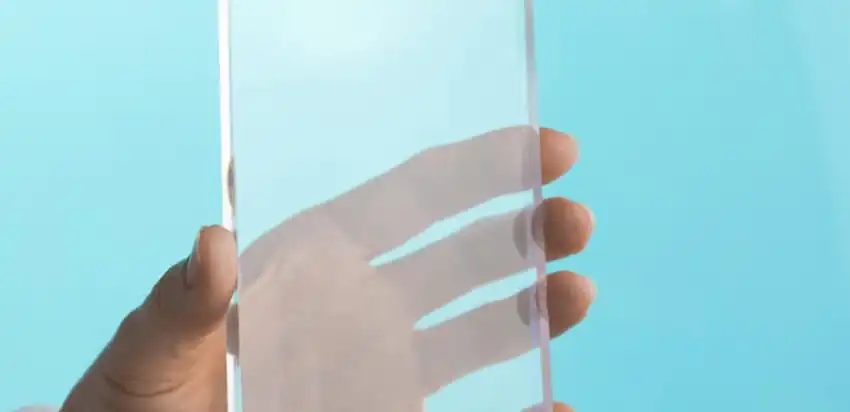
Glass Doctor why plexiglass is a durable, lightweight alternative to traditional glass.
|
OK, plexiglass isn’t glass, but what exactly is it made of? We’ve all watched that movie scene where the person is going to collide with the “glass” pane the men are carrying on the sidewalk, but unexpectedly the person bounces right off! That’s because the pane was plexiglass! As it turns out, that’s acrylic. Hooray! Now all our questions are answered …right? Maybe not. We’ve dug a little deeper for you.
What is Plexiglass Made of?
Acrylic is a transparent petroleum-based thermoplastic product often manufactured in sheets as a lightweight and shatter-resistant alternative to glass. Because of its glasslike appearance, sometimes plexiglass is referred to as acrylic glass.
To get more specific, acrylic is a synthetic polymer of methyl methacrylate, a plastic. It was developed in 1928, in several different laboratories by many different scientists around the same time. You might be intrigued to learn that acrylic sheeting is commonly referred to as plexiglass, but Plexiglas (capital P, one S) is a registered trademark dating back to 1933. You may have heard of a handful of other branded versions as well, such as Lucite and Crylux.
Plexiglass Use Across Various Industries
Plexiglass can be used much like glass because of its sturdiness and translucence. It can be made with a variety of UV and other coatings, and many industries employ plexiglass because of its versatility.
For example, manufacturers use plexiglass for light and instrument casings in vehicles, and to make appliances and eyewear lenses. In the medical and dental industries, the purity and stability of plexiglass make it perfect for prosthetics and certain devices and instruments. It’s used in submarines, airplanes, lighthouses, and sports arenas because of its durability. Artists use it to paint on or sculpt with. Plexiglass is so strong that it can even bear the pressure at the bottom of a 33-foot-deep aquarium.
Manufacturers use the sheet form of plexiglass for:
- windows
- lights
- signs
- bathtubs
- furniture and
- screens, among thousands of other things we encounter every day.
Plexiglass Uses In Everyday Life
This is truly fascinating. Let’s take a moment to appreciate the discovery and technology of this amazing substance. But unless you’re building a vehicle (seagoing or otherwise), modern art, or medical products, you might wonder, what are the more common uses of plexiglass?
- Safety Windows and Skylights: Plexiglass provides a durable and clear surface that allows natural light to pass through while protecting against impact, including from severe weather like hurricanes.
- Lighting Fixtures: Plexiglass is a staple in lighting fixture production because it offers optical clarity, resists yellowing and scratching, and creates a pleasant ambiance.
- Shower Doors and Enclosures: Thanks to its transparency, plexiglass creates a sleek and stylish appearance in bathrooms. It’s also resistant to moisture, stains, and cracks that make it ideal for shower enclosures and bathtub doors.
- Furniture: Due to its sleek, contemporary look and versatility, plexiglass is increasingly used in modern furniture designs. Its ability to be easily molded into various shapes while maintaining a high level of strength makes it a practical option for custom furniture designs.
- Protective Barriers: Plexiglass is commonly used to create protective barriers such as sneeze guards in retail stores and offices. It offers a clear, unobtrusive barrier in public spaces where combining visibility and safety are a must.
- Signage: Plexiglass is a popular material for illuminated signs and displays, as it allows light to pass through with minimal distortion, ensuring bright and vibrant visibility.
How to Repair Plexiglass
While Plexiglass is harder to shatter than regular glass, certain damage, especially cracks, may not be fully restorable without leaving some visual marks. Overall, with the right tools, minor repairs are straightforward.
- Minor Scratches: Minor knicks and scratches can often be buffed out using a polishing compound or a plastic polish designed for acrylic. DIY kits are also available for plexiglass scratch repair.
- Deeper Scratches: For more serious scratches, use fine-grit sandpaper (starting with 600 grit and finishing with 1200 grit), and follow it by polishing to restore the shine.
- Cracks: If plexiglass cracks, special acrylic adhesives or solvents can "weld" the pieces together, but the repair may be visible.
- Cleaning: When cleaning a plexiglass surface, avoid abrasive cleaners, as they can cause scratches. Instead, use mild soap and water with a soft cloth.
Plexiglass Installation and Replacement Services
The glass experts at Glass Doctor® can advise you on the many ways you can use glass and plexiglass in and around your home. If you need help repairing a plexiglass window, or replacing plexiglass in your home, Glass Doctor can help. And with backing from the Neighborly Done Right Promise®, you know we ensure your satisfaction. Contact us today to schedule your Shower door installation.
This article is intended for general informational purposes only and may not be applicable to every situation. You are responsible for determining the proper course of action for your home and property. Glass Doctor is not responsible for any damages that occur as a result of this blog content or your actions. For the most accurate guidance, contact the Glass Doctor location nearest you for a comprehensive, on-site assessment.
Plexiglass FAQ
50+ years of experience and a dedicated team of knowledgeable service professionals make Glass Doctor the one-stop solution for all your home, business, and auto glass needs. Our commitment to exceptional service and superior products includes providing answers that improve clarity on the glass topics that matter most to you. Below are answers to some of the most frequently asked questions about plexiglass.
Is Plexiglass a glass or plastic?
Plexiglass is a transparent plastic, not actual glass. It’s made from polymethyl methacrylate (PMMA), commonly used as a glass alternative. It is also sold under brand names like Lucite, Perspex, Acrylite, and Lexan.
Is Plexiglass easily breakable?
Plexiglass is a durable, impact-resistant material that is not easily breakable. However, it can scratch or break if mishandled or exposed to excessive force.
What is the lifespan of Plexiglass?
Plexiglass typically lasts 8 to 10 years in outdoor conditions, depending on the climate and exposure to artificial weathering. With proper care, it maintains its clarity and durability over time.

